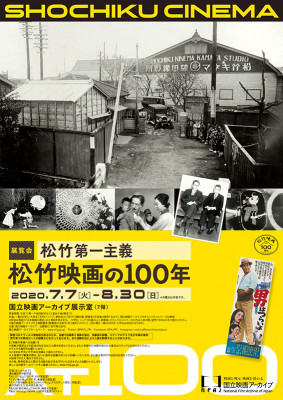Past Exhibitions
- July 7 - August 30, 2020
Shochiku Cinema at 100

- Location:
- Exhibition Gallery (7th floor)
- Date:
- Jul 7 (Tue) – Aug 30 (Sun), 2020
- Hours:
- 11:00am – 6:30pm (admission until 6:00pm)
*Last Friday of every month: 11:00am – 8:00pm (admission until 7:30pm)
*Until further notice,the hours are not extended on the last Friday of each month.
- Closed:
- Mondays
- Admission::
- Regular¥250/ University & College Students ¥130 *Free for Seniors (age 65 or over), High School Students and under 18, Disabled People (with one companion)
Please take a look at NFAJ's visitor guidelines and infection prevention measures before your visit.
For more detailed information, please see the following page (in Japanese) .
Matsujiro Shirai and Takejiro Otani were brothers who founded Shochiku in 1895 and built it into a leading force in kabuki and other entertainments. They were also believers in the future of motion pictures, a new form of popular entertainment with a growing market, and in 1920 they established Shochiku Kinema Gomei-sha and opened a studio in Kamata, Tokyo. Shiro Kido, who became the studio’s director in 1924, was a proponent of the “director system.” He focused on modern dramas and developed a unique genre called “shoshimin eiga” that depicted the joys and sorrows of the common people. Kido also played a role in developing Shochiku’s film business by venturing into the production of talkies. His lofty motto during this adolescent period of the film industry was “Shochiku First.” Shochiku Ofuna Studio opened in 1936 and won popularity by producing tasteful comedies and melodramas made in what came to be known as the “Ofuna style.” Meanwhile, its Kyoto studio was primarily making period dramas. The efforts of these studios located in eastern and western Japan combined to boost Shochiku’s reputation. Following the Second World War, works by Yasujiro Ozu, Keisuke Kinoshita, and other master directors framed the golden age of Japanese cinema. And later, Otoko wa Tsurai yo [Tora-san, Our Lovable Tramp], released during the industry’s late-1960s sunset years, and, more recently, Tsuribaka Nisshi [Free and Easy] grew into long-running series. Both earned a place in the Japanese public’s heart and splendidly inherited Shochiku’s comedy tradition.Over the past century, Shochiku suffered war and dwindling audiences, yet it continues to be a major driver of Japan’s cinematic world. This exhibit sheds light on Shochiku’s magic as a studio built on “wakon-yosai” (Japanese spirit with Western learning) and as a producer of works with innovation and tradition that are consistently in step with Japanese sensibilities.


